433 Eros
![]()
|
Images of Eros |
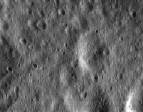 |
From April through August 2000, the NEAR Shoemaker spacecraft will map Eros in very high spatial resolution from a low altitude. Images, covering the whole, asteroid will show features as small as 4 meters across. This image, which provides a taste of the exquisite detail to come, was taken April 30, 2000, from an orbital height of 76 kilometers. |
| Hours later, an engine firing placed the spacecraft into a 50-kilometer altitude orbit. The image shows features as small as 6 meters across. The whole scene is 3 kilometers across. | |
 |
This image of Eros, taken from the NEAR Shoemaker spacecraft on May 1, 2000, is among the first to be returned from "low orbit." Between May and August, the spacecraft will orbit at altitudes near 50 kilometers or less. This is the prime period of activity for some of the spacecraft's science instruments. |
| The X-ray / gamma-ray spectrometer will build up maps of chemical abundances, while the laser rangefinder measures the shape of Eros to within meters. At the same time the magnetometer will watch for indications of Eros' magnetic field and the near-infrared spectrometer will map rock types. The imager will take pictures of the entire surface of Eros that capture features as small as 4 meters across. This particular image, taken from an orbital altitude of 53 kilometers, shows a scene about 1.8 kilometers across. Numerous craters and boulders as small as 8 meters across dot the landscape. The large, rectangular boulder at the upper right is 45 meters across. | |
 |
Eros' irregular shape creates interesting and beautiful scenes where the Sun shines obliquely on the surface. In the absence of an atmosphere, and hence no secondary illumination reflecting from atmospheric molecules, shade appears nearly as black as space. |
| This image, taken from the NEAR Shoemaker spacecraft on May 2, 2000, from an orbital altitude of 50 kilometers, shows one of the more telling and yet comical combinations of light and shadow. The entire scene is about 1.8 kilometers across. High spots near the edges of shadows, like the 35-meter diameter boulder just below the center of the frame, seem almost to "float" above the surface. With a little imagination, the shadow dominating the right side of the frame could be seen as a small, long-eared terrier bending over to sniff his dinner! | |
 |
One of the most interesting features on Eros is the "saddle," an indentation in the asteroid's peanut-like shape. The low density of impact craters inside the saddle indicates that geologic processes had modified the region relatively late in Eros' history. |
| The NEAR Shoemaker spacecraft captured this image of the inside of the saddle on May 5, 2000, from an orbital altitude of 52 kilometers. The whole scene is about 1.8 kilometers across, and the image shows features as small as 4 meters across. The bright feature running from the top to the bottom of the image is a steep, Sun-facing slope. In some places it appears to be an escarpment, while near the center of the image it appears as an inside wall of a 200-meter wide trough. The boulder in the upper right of the image is nearly 40 meters across. | |
 |
Over the past several months, NEAR Shoemaker has returned images that show a real asteroid is much more complicated and diverse than the jagged Hollywood stereotype. This image of the inside of Eros' saddle - taken May 9, 2000, from an orbital altitude of 49 kilometers - vividly demonstrates that an asteroid is a real (albeit small) world with more geologic character to its surface than just an endless collection of craters. |
| The landscape is dotted with boulders having sizes as small as the resolution of the images (8 meters). Brightness markings 20 to 400 meters across give the surface a mottled appearance. The whole scene is about 1.8 kilometers across. | |
 |
Early in NEAR Shoemaker's orbit, it became obvious that the inside of Eros' saddle-shaped indentation had been modified by geologic processes late in the asteroid's history. The evidence: In much of the saddle, the dense population of impact craters that covers most of the asteroid has been "wiped clean." |
| This image of a region inside the saddle was taken May 10, 2000, from an orbital altitude of 49 kilometers. The whole scene is about 1.8 kilometers across, and shows features as small as 4 meters. Only one sizable crater (marked by the arrow), about 80 meters across, is clearly visible. Smaller craters are scattered throughout the area but are harder to see. | |
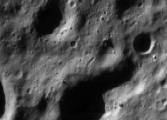 |
NEAR Shoemaker photographs Eros under a variety of lighting and viewing geometries suited to different science objectives. Taken with the Sun high in the sky, images with few shadows are best for mapping the color properties of the surface. Conversely, images taken from directly above a surface with oblique illumination are best for seeing landforms, because shadowing highlights the subtle shape changes on the asteroid's surface. |
| This image was taken at the latter geometry on May 11, 2000, from an orbital altitude of 52 kilometers. The whole scene is about 1.8 kilometers across, and shows features as small as 4 meters. The rounded nature of the landforms results from formation of small impact craters over the eons. Sharp topography is eroded away by this process, and the surface is blanketed and smoothed by the fragmental debris, or "regolith." The large boulders scattered throughout the scene are the largest fragments of the rocky regolith. | |
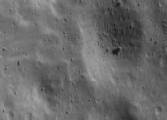 |
Low-orbit images of Eros taken by NEAR Shoemaker have shown an amazing abundance of boulders of all sizes strewn across the asteroid's surface. This image was taken on May 14, 2000, from an orbital altitude of 50 kilometers. The scene is about 1.8 kilometers across and includes features as small as 4 meters. |
| The field of boulders at the upper right is one of the rockiest parts of Eros discovered so far. The largest of the boulders is about 60 meters in diameter, nearly two-thirds the length of a football field | |
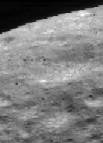 |
Some of the most aesthetically pleasing views of Eros from NEAR Shoemaker have been obtained when the camera looks at the asteroid's horizon. This image was taken on May 15, 2000, from an orbital altitude of 52 kilometers. The whole scene is about 1.4 kilometers across, and it shows features as small as 4 meters across. |
| With the Sun high overhead, shadows are minimized and surface brightness variations stand out. Mottled brightness patterns as small as 30 meters across are evident near the horizon. | |
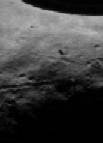 |
Images returned by NEAR Shoemaker show that Eros, like a number of other asteroids and asteroid-like moons, has a surface cut by linear troughs called "grooves." Similar features have been identified on asteroids Ida and Gaspra and on Mars' moon Phobos. However, the high-resolution images of Eros allow the origin of its grooves to be investigated in unprecedented detail. |
| This image showing several grooves was taken May 17, 2000, from an orbital altitude of 52 kilometers. The whole scene is about 1.4 kilometers across, and shows features as small as 4 meters. | |
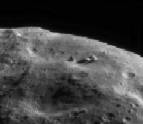 |
Pictures taken during the low-orbit phase of NEAR Shoemaker's mission to Eros are revealing the true appearance of an asteroid's surface. Eros is turning out to have diverse surface types ranging from flat to hilly, smooth to rocky, and monotonously cratered to unique in character. |
| This picture was taken for "optical navigation," that is, plotting the spacecraft's course by tracking the positions of the landmarks below. It caught a spectacular view of a horizon sculpted by worn, degraded craters and punctuated by jagged boulders. The angular boulder at the center of the frame is about 60 meters tall, or two-thirds the length of a football field. Angular rocks are very common in nature; the corners form as a rock is chipped out of a larger mass. This image was taken May 18, 2000, from an orbital altitude of 50 kilometers. The whole scene is about 1.4 kilometers across, and it shows features as small as 4 meters. | |
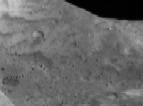 |
The inside of Eros' largest crater, which dominates one side of the asteroid, was captured in this NEAR Shoemaker image taken May 19, 2000, from an orbital altitude of 50 kilometers. The section shown is about one quarter of the whole crater and is approximately 1.4 kilometers across. |
| A cluster of large boulders sits at the bottom of the pit, and features as small as 4 meters across can be distinguished. More boulders dot the walls, which are also mottled by variations in the reflectivity of the surface layer of rock and soil, known as "regolith." | |
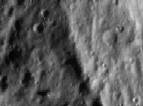 |
A particularly interesting landform on Eros is the long ridge that wraps around most of the asteroid's northern hemisphere. NEAR Shoemaker's digital camera captured part of that ridge just after local sunrise on May 20, 2000, from an orbital altitude of 50 kilometers. |
| The whole scene is about 1.4 kilometers across, and it shows features as small as 4 meters. This part of the ridge is up to 250 meters wide, but both the width and the height of the feature vary along its length. The large number of superimposed craters indicates that the ridge is a relatively old feature. | |
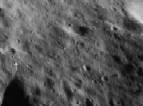 |
Some parts of Eros are so pervasively sculpted by linear grooves that the surface appears almost to have a grain to it, like wood. On May 25, 2000, the imager on NEAR Shoemaker took this picture of one such highly sculpted region from an orbital altitude of 52 kilometers. |
| The whole scene is about 1.8 kilometers across, and it shows features as small as 4 meters across. Dozens of short grooves with parallel orientations cross the terrain. One example, the short groove marked by the arrow, is 160 meters long and 40 meters wide. | |
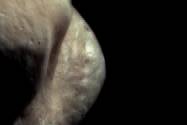 |
Color imaging of Eros from the NEAR Shoemaker spacecraft has shown the asteroid's color variations are very subdued when compared to those of other planetary bodies, such as Mars. However, both the imager and the near-infrared spectrometer have detected discernible color differences between parts of the asteroid. |
| One location on Eros with distinctive color is the eastern side of the "saddle." This color composite image of that region was taken April 2, 2000, from an orbital altitude of 201 kilometers. In this false color representation, the red and green image planes were taken in different wavelengths of infrared light, and the blue image plane was taken in blue light. NEAR scientists interpret the bright and greenish-gray appearing regions near the rim of the saddle to represent relatively fresh exposures of subsurface soil. In contrast, the pinkish looking soil covering other areas is thought to have been modified by exposure to small impacts and the solar wind. | |
 |
Among the surface features on Eros that have become familiar from NEAR Shoemaker images are the "saddle," grooves, boulders, and brightness markings on the steep sides of various landforms. This image of the inside of the "saddle" combines them all. It was taken May 30, 2000, from an orbital altitude of 49 kilometers. |
| The scene is 1.8 kilometers wide, and features as small as 4 meters across are visible. In this picture, the landscape is illuminated by the Sun high in the sky. This lighting emphasizes differences in the reflectivity of surface materials, and topographic relief appears subdued. The curved feature extending from lower left to upper right is the inside of a broad, shallow groove. Bright material covers parts of the groove's walls. Several boulders dot the right half of the scene. The boulder poised near the edge of the groove (upper right) is about 60 meters across. | |
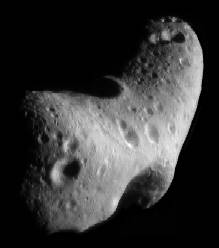 |
While NEAR Shoemaker orbits Eros, the asteroid appears too large for the camera's field of view. In order to get a complete view of the surface from a particular vantage point, several images are mosaicked. To do this, the digital images returned by the spacecraft are draped over a computer model of the asteroid's shape. This spectacular view -- looking down on the north polar region -- was constructed from six images taken February 29, 2000, from an orbital altitude of about 200 kilometers. |
| This vantage point highlights the major physiographic features of the northern hemisphere: the saddle seen at the bottom; the 5.3-kilometer diameter crater at the top; and a major ridge system running between the two features that spans at least one-third of the asteroid's circumference. | |
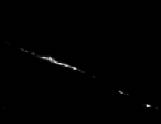 |
On June 3, 2000, NEAR Shoemaker's imager took this surrealistic picture of Eros from an orbital altitude of 51 kilometers. An unimaginably thin crescent appears almost to hang in space. The thin sliver of light is the far wall of a crater, still sunlit just seconds before sunset. |
| In the foreground, high terrain on Eros' night side blocks all but the uppermost 25 meters of the crater's wall. The whole scene is 2.1 kilometers wide. | |
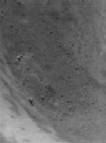 |
NEAR Shoemaker continues to take pictures of Eros under different lighting conditions and at better spatial resolution. This approach maximizes the amount of recognizable detail in the surface, while placing that detail into the context of the asteroidís large-scale geography. This image approximates the view from the edge of the large, 5.3-kilometer diameter crater, looking into its depths. |
| It was acquired on June 6, 2000, from an orbital altitude of 49 kilometers. The whole scene is 1.4 kilometers across. | |
 |
Since the NEAR Shoemaker spacecraft began orbiting Eros on February 14, 2000, the Sun has been moving to more southerly latitudes. Most of the asteroid that was in darkness in late February is now sunlit for part of Eros' day. This image, taken June 9, 2000, from an orbital altitude of 51 kilometers, shows part of the asteroid's western hemisphere that was dark in the mission's early stage. |
| This side of Eros, where the large 5-kilometer diameter crater is located, is concave shaped. The surface slopes down and away in the lower part of the picture, then up for the top three-quarters. The whole scene is 1.2 kilometers across. | |
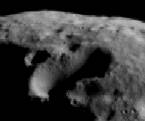 |
Some impact craters occurring on Earth and on other planetary bodies come in close pairs. These double craters are sometimes the result of the chance superimposition of two distinct impact events. However, a few double craters are also thought to have formed by the impact of two similarly sized bodies that are traveling in close orbit or touching each other. |
| The near-Earth asteroid 4769 Castalia, which has been imaged by radar, is one of the most promising candidates for being such a "contact binary." This image, taken on June 10, 2000, from an orbital altitude of 51 kilometers, caught an obliquely illuminated view of a double crater on Eros. The two craters are so close to each other that they merge into the single dumbell-shaped depression in the center of the image. Each of the two craters is about 550 meters across. The whole scene is 1.9 kilometers across. | |
![]()
Last updated: March 15, 2002.